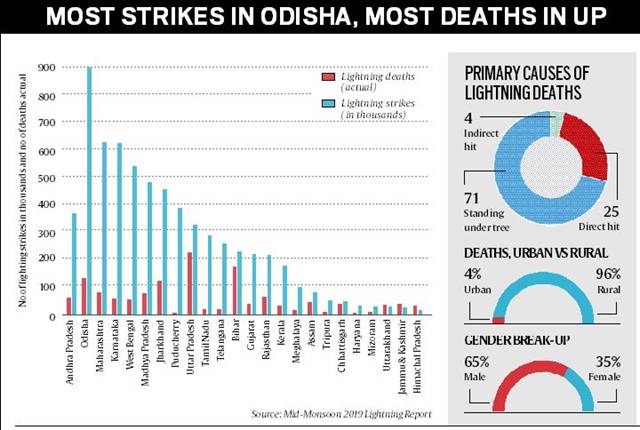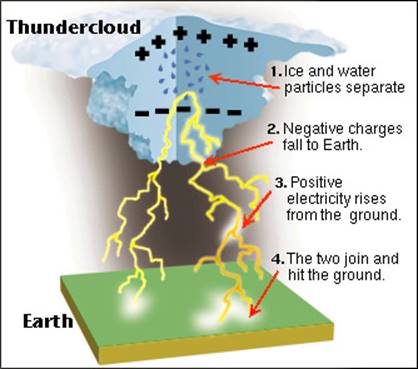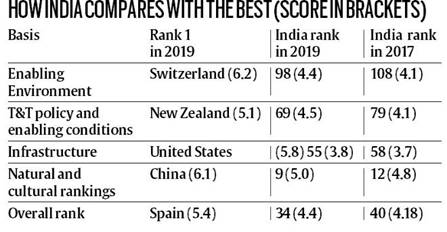



Explained: Mapping lightning across India
Lightning strikes have caused at least 1,311 deaths in the four-month period between April and July this year, according to a first-of-its-kind report on lightning incidents in India.
- Climate Resilient Observing Systems Promotion Council (CROPC), a non-profit organisation that works closely with India Meteorological Department (IMD), has prepared it.
- 36 per cent of lightening happened to be cloud-to-ground lightning, the kind that reaches the Earth.
- Remaining were in-cloud lightning, which remains confined to the clouds in which it was formed.
- Odisha recorded maximum lightening.
- The report is part of an effort to create a database that can help develop an early warning system for lightning, spread awareness, and prevent deaths.
- It is possible to predict, 30-40 minutes in advance, when a lightning strike heads towards Earth.
- The IMD has begun providing lightning forecasts and warnings through mobile text messages from this year.

- Lightning is a very rapid and massive discharge of electricity in the atmosphere.
- It is a result of the difference in electrical charge between the top and bottom of a cloud.
- The lightning-generating clouds are typically about 10-12 km in height, with their base about 1-2 km from the Earth’s surface.
- As water vapour moves upwards in the cloud, it condenses into water due to decreasing temperatures.
- A huge amount of heat is generated in the process, pushing the water molecules further up.
- As they move to temperatures below zero, droplets change into small ice crystals.
- As they continue upwards, they gather mass, until they become so heavy that they start descending.
- It leads to a system where smaller ice crystals move upwards while larger ones come down.
- The resulting collisions trigger release of electrons, in a process very similar to the generation of electric sparks.
- The moving free electrons cause more collisions and more electrons; a chain reaction is formed.

- The process results in a situation in which the top layer of the cloud gets positively charged while the middle layer is negatively charged.
- The electrical potential difference between the two layers is huge, of the order of billions of volts.
- In little time, a huge current, of the order of lakhs to millions of amperes, starts to flow between the layers.
- It produces heat, leading to the heating of the air column between the two layers of cloud.
- It is because of this heat that the air column looks red during lightning.
- The heated air column expands and produces shock waves that result in thunder sounds.
- The Earth is a good conductor of electricity.
- While electrically neutral, it is relatively positively charged compared to the middle layer of the cloud.
- As a result, an estimated 20-25 per cent of the current flow gets directed towards the Earth.
- It has a greater probability of striking raised objects on the ground, such as trees or buildings.
- State governments should take the data from IMD installed sensors, start an emergency response system, and relay the information to the district level.
- Location-based SMS services is available, but this is not done in many states.
- After receiving alerts from IMD, Odisha send pre-fixed messages to the grassroots utilising their network.
- Vulnerable people have been trained how to respond after hearing the warning siren.
- Safe shelters were created.
- Lightning arresters have been installed on many buildings.
- Mayurbhanj, which saw 152 deaths last year, recorded only 17 this year.
- The state took proactive measures like changing housing patterns, providing education.
- They planted palm trees, which attract high-voltage electricity.
- Engagement with other disasters as it happened in Bihar.
- Bureaucratic hurdles in disseminating the information as happened in UP.
- Lack of man power with State disaster response authority as happened in Jharkhand.
- Lack of awareness among people even receiving the alert.
- Areas prone to heatwaves were also prone to lightning.
- Pollution increases aerosols in the atmosphere, which in turn increases lightning.
- There have been at least two or three instances of lightning strikes without rainfall.
Reference: https://indianexpress.com/article/explained/mapping-lightning-across-india-imd-weather-prediction-5970345/\
A report released by the World Economic Forum (WEF) on Wednesday ranks the travel & tourism competitiveness of 140 economies.
- It is a biennial report means published in two years.
- It scored countries on four indicators — enabling environment; travel and tourism policy and enabling conditions; infrastructure; natural and cultural rankings.
- World Economic Forum publishes it.
- India’s highest improvement was in enabling environment, by 10 places to 98.
- The least improvement is in infrastructure as well as in natural and cultural rankings, by just three places each, but India’s rank was already high in the latter.
- The four broad indicators looked at 14 variables, which were further subdivided into 90 indicators such as property rights, efficiency of the legal framework, quality of electricity supply, female labour force participation, visa requirements and the number of World Heritage cultural sites.

Reference: https://indianexpress.com/article/explained/india-rises-in-wef-travel-rankings-how-countries-scored-5970399/
- Modi also unveiled the "Act Far East" policy to boost India's engagement with Russia's Far East region.
- India has already announced development grants to Asia , Africa and Latin America . But it has mostly gone to poorer countries.
- This time India has announced the aid to a developed country.
- Earlier, India had also been a major recipient of Soviet aid, cornering about a quarter of the aid the USSR gave to developing countries.
- The Russian economy has been struggling since 2014, weighed down by the international sanctions that followed the annexation of Crimea and the collapse in oil prices five years ago.
- Russia wants to develop faster its Far East region.
- Russia is heavily dependent on the China for its development and wants to diversify the partners. India can play a critical role in it.
- Soft loans have been an important diplomatic tool to sustain political influence in the neighbourhood.
- It helps to counter the growing Chinese presence, especially in Africa.
- Indian Line of Credit is a demand raised by the recipient country is also in contrast to the Chinese Belt and Road model, which threatens to put many countries in a debt trap.
- The increase and decrease in grants also sometimes reflects the politics of the times. For instance, while the flow of funds to Nepal has been consistent, it went up for Maldives after the change in government last year.
Reference: https://timesofindia.indiatimes.com/india/india-extends-1-billion-line-of-credit-for-development-of-russias-far-east/articleshow/70991706.cms?utm_source=nl_landingpage&utm_medium=web&utm_campaign=timestop10_daily_newsletter
The plan to merge ten public sector banks into four amid economic growth falling to a six-year low, has generated a lot of talking points. One of them is why can't the government sell its stake in these banks and privatise them.
- Government can use its freed time, space and money for other purposes.
- Our financial sector has become wide enough to cover all the population’s need.
- Research shows that private banks exhibit significantly higher productivity and growth than PSBs.
- Various committees have said that boards of most PSBs are increasingly compromised and lack the requisite sense of purpose.
- Most of the government's social goals can be pursued through RBI regulations and directives to private sector banks.
- A country of our size requires a lot of inclusive banking which is largely being done by the PSBs.
- PSB does certain social obligation which cant be done by the private commercial banks.
- Private banks have also been poorly governed and is not a panacea for all problems.
- We need to look at pragmatic ways to improve governance across the board.
- We can privatise one or two mid-sized public sector banks and reduce the government stake below 50% for a couple of others, while working on governance reforms for the rest.
Reference: http://www.businessworld.in/article/We-Need-Public-Sector-Banks-For-At-Least-Another-10-15-years-Says-SBI-s-Rajnish-Kumar/02-06-2019-171294/?utm_source=nl_landingpage&utm_medium=web&utm_campaign=timestop10_daily_newsletter

© 2025 iasgyan. All right reserved